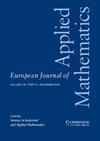Derivation and travelling wave analysis of phenotype-structured haptotaxis models of cancer invasion
IF 1.1
4区 数学
Q1 MATHEMATICS, APPLIED
引用次数: 0
Abstract
We formulate haptotaxis models of cancer invasion wherein the infiltrating cancer cells can occupy a spectrum of states in phenotype space, ranging from ‘fully mesenchymal’ to ‘fully epithelial’. The more mesenchymal cells are those that display stronger haptotaxis responses and have greater capacity to modify the extracellular matrix (ECM) through enhanced secretion of matrix-degrading enzymes (MDEs). However, as a trade-off, they have lower proliferative capacity than the more epithelial cells. The framework is multiscale in that we start with an individual-based model that tracks the dynamics of single cells, which is based on a branching random walk over a lattice representing both physical and phenotype space. We formally derive the corresponding continuum model, which takes the form of a coupled system comprising a partial integro-differential equation for the local cell population density function, a partial differential equation for the MDE concentration and an infinite-dimensional ordinary differential equation for the ECM density. Despite the intricacy of the model, we show, through formal asymptotic techniques, that for certain parameter regimes it is possible to carry out a detailed travelling wave analysis and obtain invading fronts with spatial structuring of phenotypes. Precisely, the most mesenchymal cells dominate the leading edge of the invasion wave and the most epithelial (and most proliferative) dominate the rear, representing a bulk tumour population. As such, the model recapitulates similar observations into a front to back structuring of invasion waves into leader-type and follower-type cells, witnessed in an increasing number of experimental studies over recent years.癌症侵袭表型结构游走模型的推导和游走波分析
我们提出了癌症侵袭的游走模型,其中浸润的癌细胞可以在表型空间中占据一系列状态,从 "完全间质 "到 "完全上皮 "不等。间质细胞越多,就越能表现出更强的牵引反应,并且通过增强基质降解酶(MDEs)的分泌来改变细胞外基质(ECM)的能力也就越强。然而,作为一种权衡,它们的增殖能力低于上皮细胞。该框架是多尺度的,我们从基于个体的模型开始,跟踪单个细胞的动态,该模型基于代表物理空间和表型空间的晶格上的分支随机行走。我们正式推导出相应的连续模型,该模型采用耦合系统的形式,包括局部细胞群密度函数偏积分微分方程、MDE 浓度偏微分方程和 ECM 密度无穷维常微分方程。尽管模型错综复杂,但我们通过形式渐近技术表明,在某些参数情况下,可以进行详细的行波分析,并获得表型空间结构的入侵前沿。确切地说,大部分间质细胞占据入侵波的前沿,而大部分上皮细胞(和增殖能力最强的细胞)则占据后方,这代表了大量肿瘤细胞。因此,该模型再现了近年来越来越多的实验研究中观察到的入侵波由前向后分为领导型细胞和追随者型细胞的类似结构。
本文章由计算机程序翻译,如有差异,请以英文原文为准。
求助全文
约1分钟内获得全文
求助全文
来源期刊
CiteScore
4.70
自引率
0.00%
发文量
31
审稿时长
>12 weeks
期刊介绍:
Since 2008 EJAM surveys have been expanded to cover Applied and Industrial Mathematics. Coverage of the journal has been strengthened in probabilistic applications, while still focusing on those areas of applied mathematics inspired by real-world applications, and at the same time fostering the development of theoretical methods with a broad range of applicability. Survey papers contain reviews of emerging areas of mathematics, either in core areas or with relevance to users in industry and other disciplines. Research papers may be in any area of applied mathematics, with special emphasis on new mathematical ideas, relevant to modelling and analysis in modern science and technology, and the development of interesting mathematical methods of wide applicability.

 求助内容:
求助内容: 应助结果提醒方式:
应助结果提醒方式:


